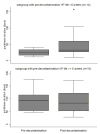Biofilm on the tracheoesophageal voice prosthesis: considerations for oral decontamination
- PMID: 27400694
- PMCID: PMC5225050
- DOI: 10.1007/s00405-016-4193-0
Biofilm on the tracheoesophageal voice prosthesis: considerations for oral decontamination
Abstract
The tracheoesophageal puncture (TEP) restores verbal communication after total laryngectomy using a one-way valved voice prosthesis (VP). Microbial colonization can shorten VP device life. Our aims were to investigate patterns of prosthetic and oral colonization, and record changes in VP device life after targeted decontamination. We conducted a retrospective review of TEP clinic patients who underwent microbial analysis of the VP between 01/2003 and 07/2013. Two subgroups were analyzed: (1) patients with microbial analysis of the VP and the mouth were analyzed to identify patterns of common contamination, and (2) patients who were prescribed targeted oral decontamination on the basis of the microbial analysis of the VP were analyzed to evaluate effects on device life. Among 42 patients, 3 patients had only fungal, 5 only bacterial, and 33 had polyspecies fungal and bacterial colonization. In the TEP-oral microflora subgroup (n = 15), 7 had common microorganisms in the mouth and on the VP. Among the decontamination subgroup (n = 23), 6 patients received broad spectrum rinse, 16 antifungal agents and 13 antibiotics, or a combination thereof. After targeted decontamination, the median device life of prostheses improved from 7.89 to 10.82 weeks (p = 0.260). The majority of patients with a suboptimal VP device life in this pilot had polyspecies bacterial and fungal colonization. VPs rarely had fungal contamination alone (3 %), and non-albicans fungal species were more common than expected. For these reasons, we are exploring the use of targeted decontamination regimens that were associated with 1.4-fold improvement in VP duration.
Keywords: Antibiotics; Antifungal therapy; Culture and sensitivity; Decontamination; Device life; Microbiological culture; Tracheoesophageal puncture; Voice prosthesis.
Conflict of interest statement
The authors declared that they have no conflicts of interest to this work.
Figures





References
-
- Tomeh C, Holsinger FC. Laryngeal cancer. Curr Opin Otolaryngol Head Neck Surg. 2014;22(2):147–153. - PubMed
-
- Kazi R, Sayed SI, Dwivedi RC. Post laryngectomy speech and voice rehabilitation: past, present and future. ANZ J Surg. 2010;80(11):770–771. - PubMed
-
- Singer MI, Blom ED. An endoscopic technique for restoration of voice after laryngectomy. Ann Otol Rhinol Laryngol. 1980;89(6 Pt 1):529–533. - PubMed
-
- Bauters TGM, Moermann M, Vermeersch H, Nelis HJ. Colonization of voice prostheses by albicans and non-albicans Candida species. Laryngoscope. 2002;112:708–712. - PubMed
-
- van Weissenbruch R, Albers FW, Bouckaert S, et al. Deterioration of the Provox silicone tracheoesophageal voice prosthesis: microbial aspects and structural changes. Acta Otolaryngol. 1997;117(3):452–458. - PubMed
MeSH terms
Grants and funding
LinkOut - more resources
Full Text Sources
Other Literature Sources

